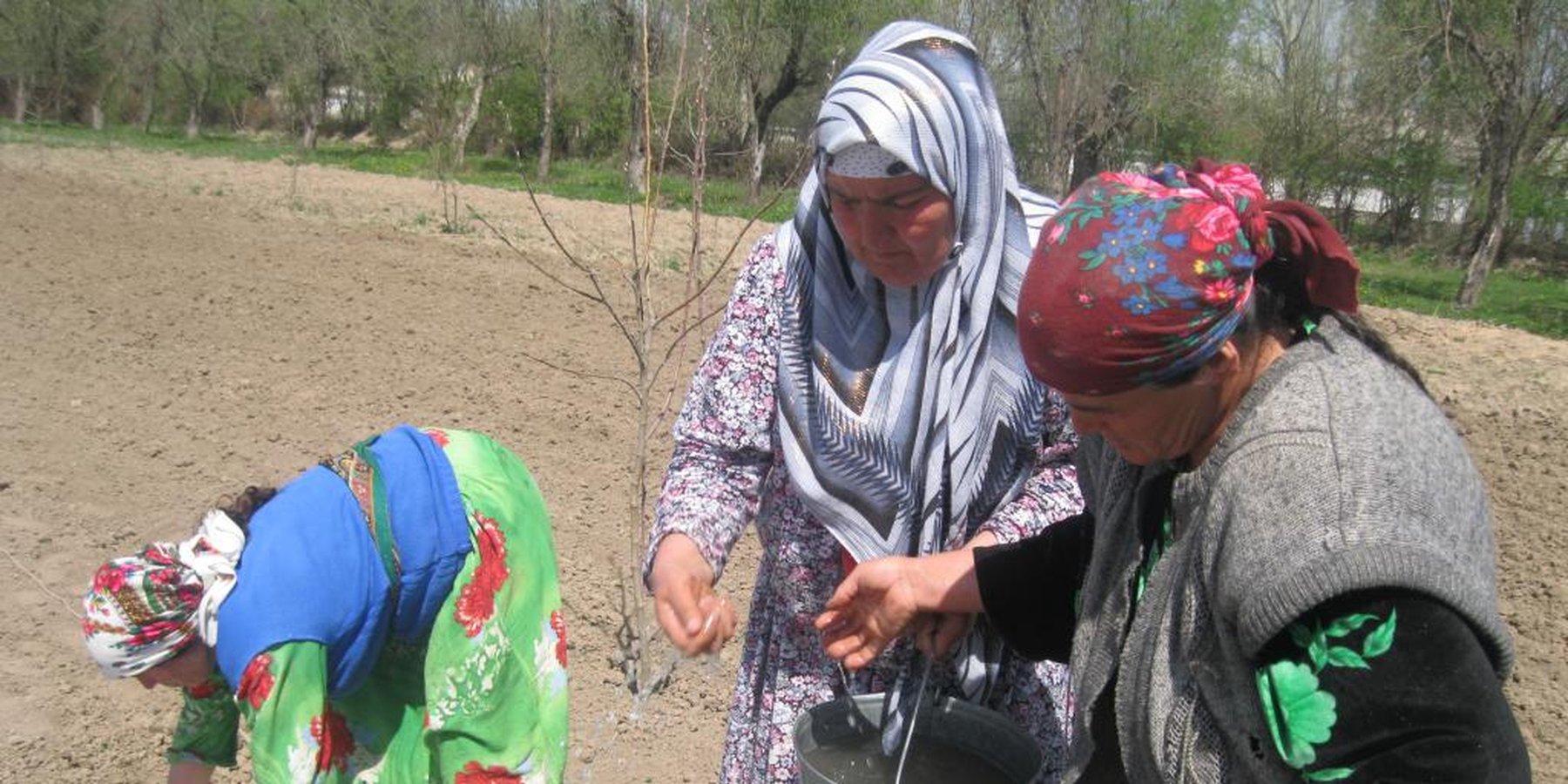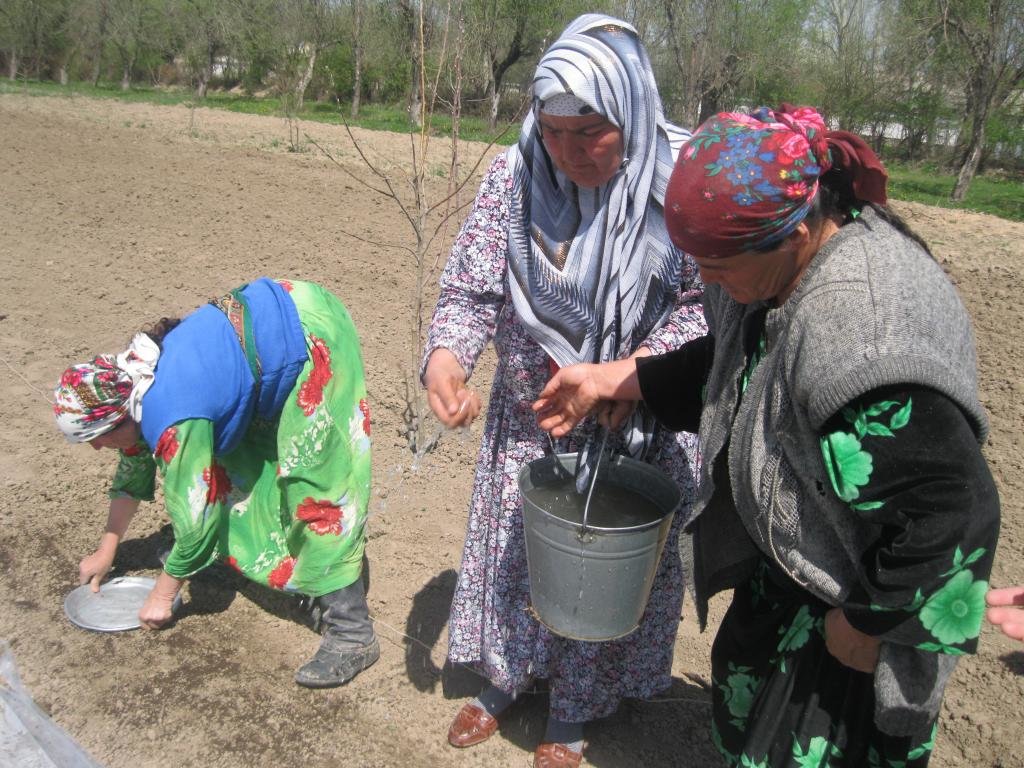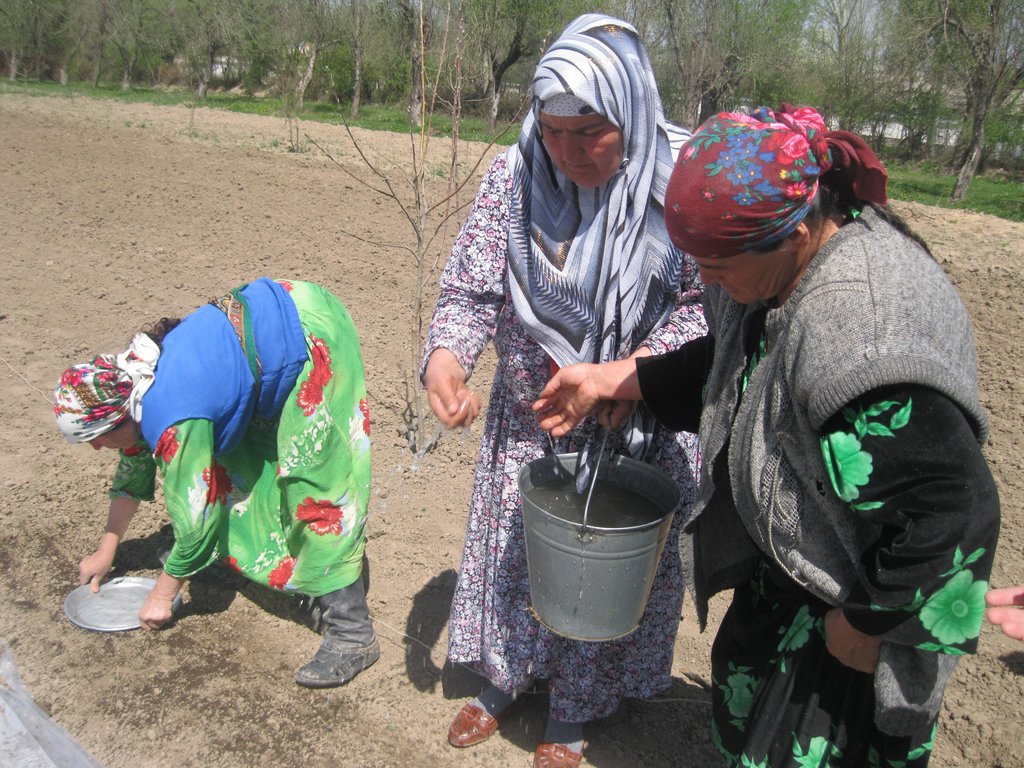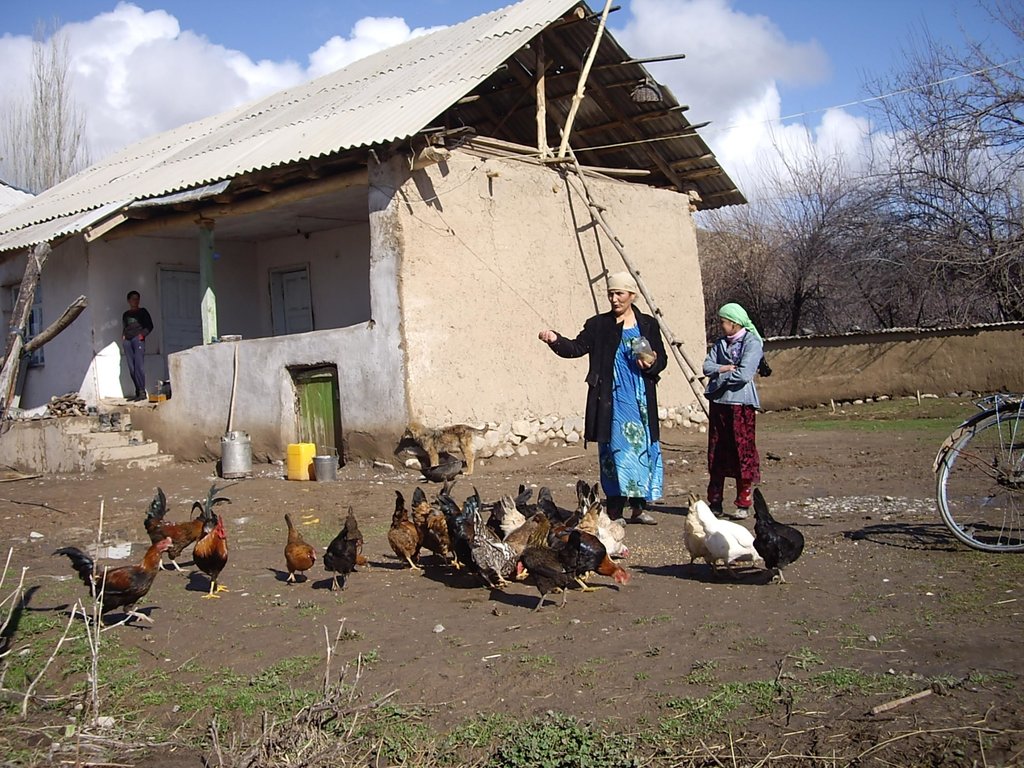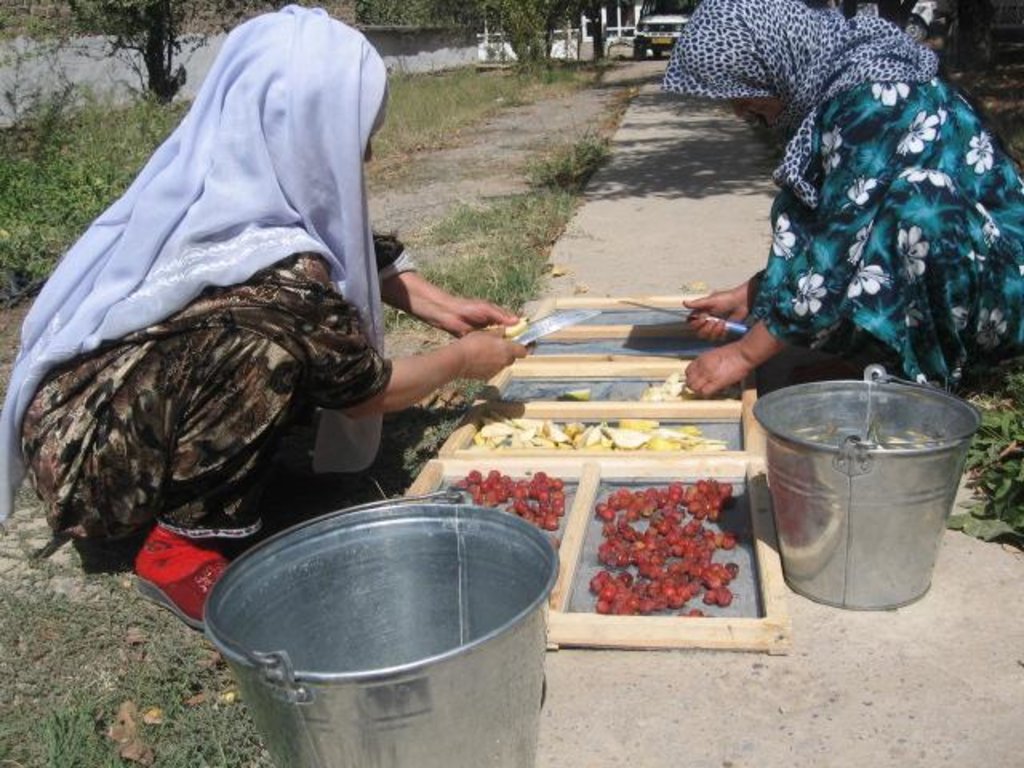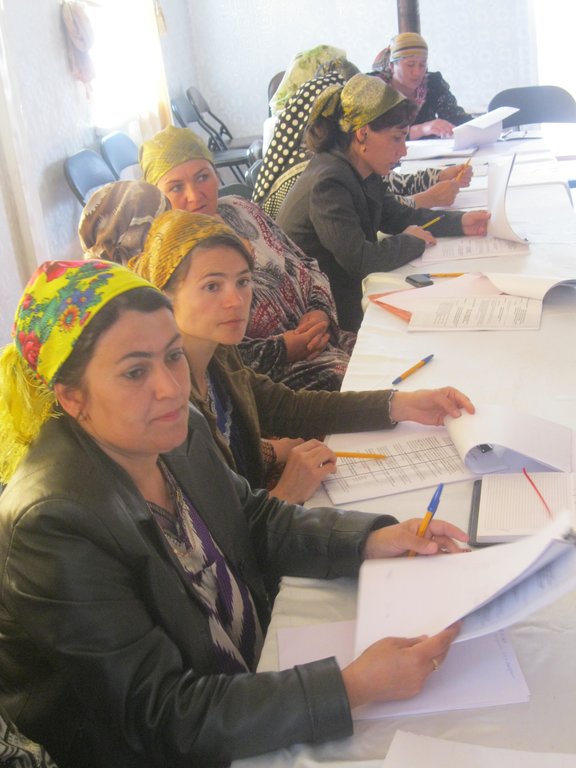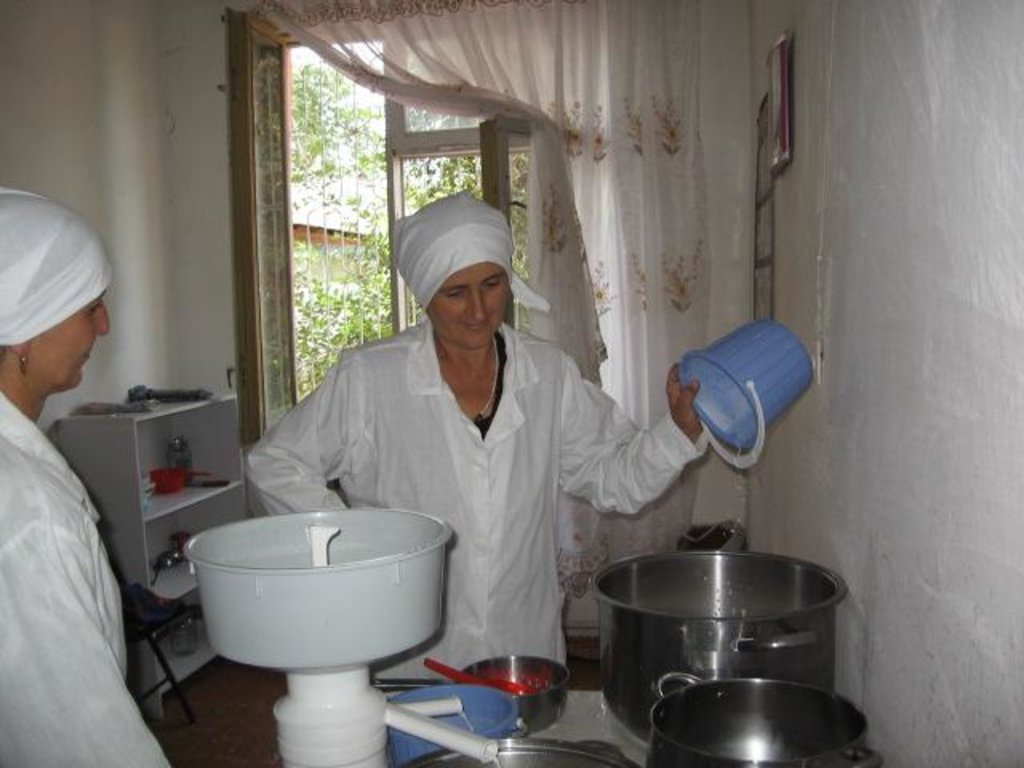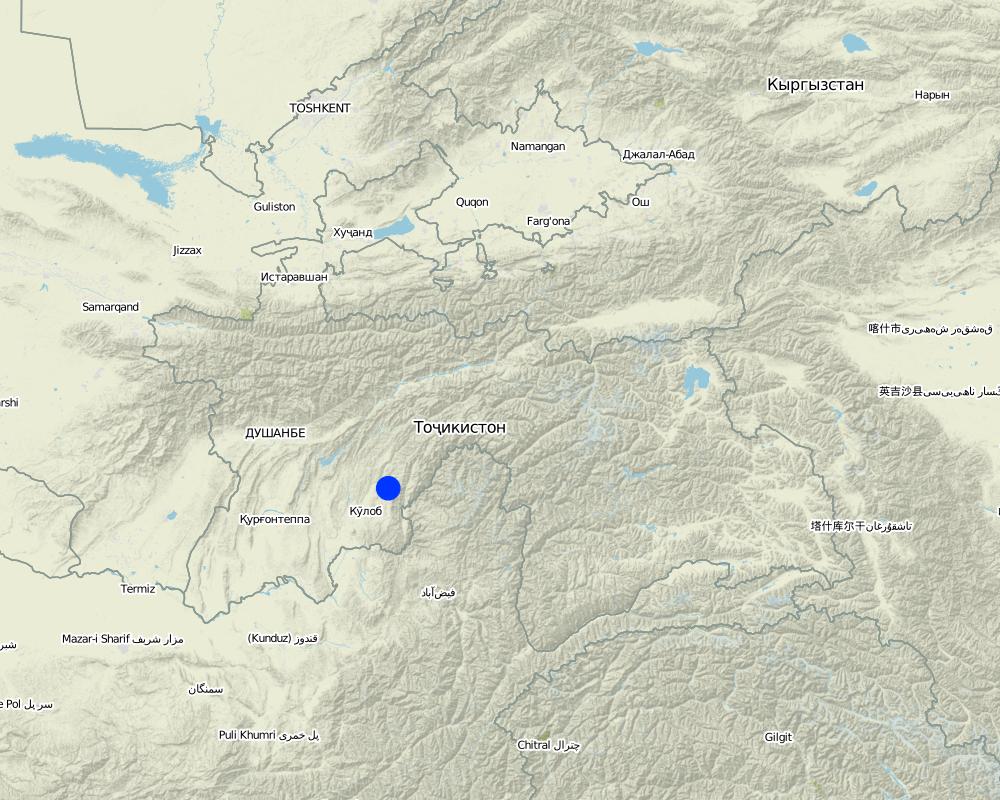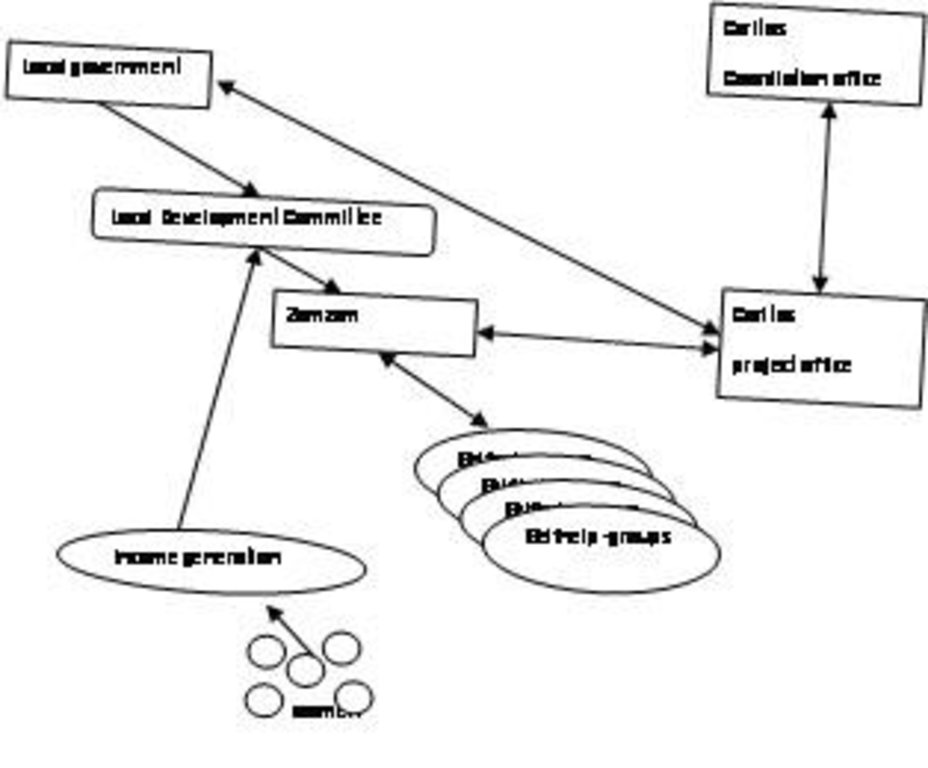Public Women's Organisation Zamzam - enhancing incomes for poor women through income generation activities [Tadjikistan]
- Création :
- Mise à jour :
- Compilateur : Lisa Gampp
- Rédacteur : –
- Examinateur : David Streiff
approaches_2438 - Tadjikistan
- Résumé complet en PDF
- Résumé complet en PDF pour impression
- Résumé complet dans le navigateur
- Résumé complet (non formaté)
- Public Women's Organisation Zamzam - enhancing incomes for poor women through income generation activities: 6 juillet 2017 (inactive)
- Public Women's Organisation Zamzam - enhancing incomes for poor women through income generation activities: 9 août 2017 (inactive)
- Public Women's Organisation Zamzam - enhancing incomes for poor women through income generation activities: 2 novembre 2021 (public)
Voir les sections
Développer tout Réduire tout1. Informations générales
1.2 Coordonnées des personnes-ressources et des institutions impliquées dans l'évaluation et la documentation de l'Approche
Spécialiste GDT:
Spécialiste GDT:
Burkhanova Navzuna
mburkhaonva@caritas.ch
Caritas Switzerland in Tajikistan
Pavlova 20, Dushanbe
Tadjikistan
Nom du ou des institutions qui ont facilité la documentation/ l'évaluation de l'Approche (si pertinent)
CARITAS (Switzerland) - Suisse1.3 Conditions relatives à l'utilisation par WOCAT des données documentées
Le compilateur et la(les) personne(s) ressource(s) acceptent les conditions relatives à l'utilisation par WOCAT des données documentées:
Oui
2. Description de l'Approche de GDT
2.1 Courte description de l'Approche
The development of a women's network to disseminate information, provide training, and provide support to other women in the community to help them improve their livelihoods, and provide a forum by which women's issues can be raised at a local level.
2.2 Description détaillée de l'Approche
Description détaillée de l'Approche:
Aims / objectives: The overriding objective of the creation of a women's group was to provide an approach, by which activities could be implemented to improve the livelihoods of women in this rural region. Women are considered a vulnerable group due to high rates of labour migration by many men to Russia. This leaves the women behind, to care for the children, tend the kitchen garden, rear animals and other duties that they have limited experience and training in completing. The creation of a women’s network was seen as an opportunity to unite women, and provide them with trainings, skills and livelihood opportunities so that they could improve not only their standard of living but also that of their families. Zamzam was also designed to act as a focal point for voicing women's issues with local representatives and local government, and to help raise the profile of women in the decision making process.
Methods: The organisation, Zamzam was set up initially with funding from an INGO, via a project, however to remain as a viable women’s network, they have several paid staff, secure funding through membership fees and sell dairy products on the local market. The core staff have received support from Caritas and Voluntary Services Overseas (VSO) on areas like business planning, organisational development and marketing to encourage autonomy and sustainability in the future as financial support is withdrawn. In addition Zam Zam members are taught technical skills in dairy production, energy efficiency, soil conservation, basic farming techniques etc which are then taken back to the respective communities and conveyed back to the women of the community. This network creates a safe environment for learning, discussing and planning using the most active women members as conduits for the transfer of information and ideas.
Stages of implementation: The establishment of Zamzam follows a basic business model, whereby a board of directors is established to oversee the daily running of the organisation, periodically meeting to discuss planning, finance, reporting, employment etc. This is supplemented by a bi-annual members meeting whereby all the members of Zamzam meet, and are provided with information on the network performance. This ensures that the members are fully briefed and that the operations remain transparent. This is also an opportunity to vote for new board members, suggest new directions, discuss membership fees, and provide feedback on implemented activities. Zamzam has also developed a business strategy and charter to provide guidelines and direction for its members.
Role of stakeholders: There are three main types of stakeholders; the first are the board and paid staff of the organisation, who oversee the day to day running, the second are the members who participate in training and income generating activities, and act as information points in their respective communites to the third set of stakeholders; the women who are not members but who can still benefit from improved knowledge and support.
2.3 Photos de l'approche
2.5 Pays/ région/ lieux où l'Approche a été appliquée
Pays:
Tadjikistan
Région/ Etat/ Province:
Khatlon
Autres spécifications du lieu :
Muminabod
Map
×2.6 Dates de début et de fin de l'Approche
Indiquez l'année de démarrage:
2008
Date (année) de fin de l'Approche (si l'Approche n'est plus appliquée):
2013
2.7 Type d'Approche
- fondé sur un projet/ programme
2.8 Principaux objectifs de l'Approche
The Approach focused mainly on other activities than SLM (Increase income and assets of vulnerable women, and their families, and enhance participation of women at planning and helping to direct development by uniting women to reduce poverty)
To improve the sustainable livelihoods of women within the community by increasing their knowledge and providing opportunity for income generation (e.g. dairy production, crop production, food processing, poultry production). In addition, to establish a women’s network to share ideas and resources, and provide a viable platform by which the specific concerns of women can be raised and presented to local decision makers.
The SLM Approach addressed the following problems: To improve the sustainable livelihoods of women, one of the more vulnerable members of society. Increasingly since the collapse of the Soviet Union, the position of women within the community has become restricted. Previous social structures have diminished, and many male family members are working in Russia, taking with them their knowledge and labour skills. As a result women are left to bring up and support families, tend to the land and livestock and deal with day to day financial issues. This increased responsibility combined with a lack of knowledge, finance and experience has meant that the position of women in the community has become more exposed and subsequently vulnerable.
2.9 Conditions favorisant ou entravant la mise en œuvre de la(des) Technologie(s) appliquée(s) sous l'Approche
normes et valeurs sociales/ culturelles/ religieuses
- entrave
There are large scale labour migration issues, leaving women with limited skill sets to run the family households. When the male members of the family return they resume their original tasks and the women resort to a more traditional roles.
Treatment through the SLM Approach: The women's organisation encourages and supports women in continuing with their new tasks and responsibilities.
disponibilité/ accès aux ressources et services financiers
- entrave
Women have very little access to money, with many not having regular incomes or viability to access finance.
Treatment through the SLM Approach: Zamzam provides low cost training through outreach workers and materials and equipment for the implementation of improved livelihood measures.
cadre institutionnel
- entrave
The women have a low level of education, which hinders activities such as planning, budgeting and implementation of activities.
Treatment through the SLM Approach: The key staff were provided with external support and training to aid staff development, this was supplemented with the development of an organisational strengthening plan for the first year.
cadre juridique (régime foncier, droits d'utilisation des terres et de l'eau)
- entrave
Zamzam needed to secure some sort of legal status to be able to strengthen and incorporate income generating activities.
Treatment through the SLM Approach: Zamzam registered as a legal entity.
connaissances sur la GDT, accès aux supports techniques
- entrave
The women did not have the technical knowledge to enhance the livelihoods of other women.
Treatment through the SLM Approach: Training was provided on key technical aspects such as energy and soil conservation by the project.
3. Participation et rôles des parties prenantes impliquées dans l'Approche
3.1 Parties prenantes impliquées dans l'Approche et rôles
- exploitants locaux des terres / communautés locales
The women of the Muminobod district.
It is a women's group designed to support women, therefore the involvement of men was peripheral.
The approach is targeted at women, this included women who have been abandoned by their husbands, and others who are now responsible for the household due to the fact that the male members of the family are working away in Russia. These women are considered to be a vulnerable group who need support, training, information to help themselves to improve their livelihoods.
- Spécialistes de la GDT/ conseillers agricoles
- gouvernement local
Local authorities
Local government in recognition of the group and involvement in the local development committee.
- organisation internationale
Caritas Switzerland
Caritas built the capacity and supported the organisational development
3.2 Participation des exploitants locaux des terres/ communautés locales aux différentes phases de l'Approche
| Participation des exploitants locaux des terres/ communautés locales | Spécifiez qui était impliqué et décrivez les activités | |
|---|---|---|
| initiation/ motivation | passive | The creation of the initial concept was provided by an INGO, however, some more active women supported its conception. |
| planification | aucun | The planning of the network was undertaken by INGO staff and a few women representatives. |
| mise en œuvre | auto-mobilisation | Zamzam was established in response and the wishes of the local women to create a network to promote income generating activities. Caritas field office staff had the capacity and knowledge to provide technical advice to the self-help groups. |
| suivi/ évaluation | interactive | Zamzam have to monitor and evaluate their own performance and provide information to donors who have supported them. |
| Research | passive | market specialists are responsible for the research in order to enhance the market potential of the products, to increase income. |
3.3 Diagramme/ organigramme (si disponible)
Description:
An overview of the organisational set up of Zamzam.
Auteur:
Caritas Switzerland (Dushanbe)
3.4 Prises de décision pour la sélection de la Technologie/ des Technologies
Indiquez qui a décidé de la sélection de la Technologie/ des Technologies à mettre en œuvre:
- les spécialistes de la GDT seuls
Expliquez:
The project instigated the formation of the women's network.
Decisions on the method of implementing the SLM Technology were made by mainly by SLM specialists with consultation of land users
4. Soutien technique, renforcement des capacités et gestion des connaissances
4.1 Renforcement des capacités/ formation
Une formation a-t-elle été dispensée aux exploitants des terres/ autres parties prenantes?
Oui
Spécifiez qui a été formé:
- exploitants des terres
- personnels/ conseillers de terrain
Formats de la formation:
- sur le tas
- cours
Thèmes abordés:
Proper care for cattle, milk collection, hygiene and sanitation in the milk sector, growing and collecting herbs, such as calendula, chamomile, etc
4.2 Service de conseils
Les exploitants des terres ont-ils accès à un service de conseils?
Oui
Spécifiez si le service de conseils est fourni:
- dans les champs des exploitants?
Décrivez/ commentez:
Voluntary Services Overseas: Key elements: Training on marketing and business planning, Training on dairy production.; VSO supported Zamzam by providing international volunteers to help support their activities, and provide training and advisory services.
Advisory service is quite adequate to ensure the continuation of land conservation activities; Zamzam learnt much from the VSO support provided, and is now in a position to further help other networks.
4.3 Renforcement des institutions (développement organisationnel)
Des institutions ont elles été mises en place ou renforcées par le biais de l'Approche?
- oui, modérément
Spécifiez à quel(s) niveau(x), ces institutions ont été renforcées ou mises en place:
- local
Précisez le type de soutien:
- renforcement des capacités/ formation
Donnez plus de détails:
NGO Zamzam hired a local training institution ATAC in Kulob to train Zamzam’s members on various topics related to agriculture.
4.4 Suivi et évaluation
Le suivi et l'évaluation font ils partie de l'Approche? :
Oui
Commentaires:
economic / production aspects were ad hoc monitored by project staff through observations; indicators: None
no. of land users involved aspects were regular monitored by project staff through measurements; indicators: None
management of Approach aspects were ad hoc monitored by project staff through observations; indicators: None
There were few changes in the Approach as a result of monitoring and evaluation: Since there was no market to sell certain items, Zamzam changed their focus and started investigating other products that the women could produce, and provide a respectable return on their invested time and effort. Zamzam consulted market specialists as part of this process.
There were few changes in the Technology as a result of monitoring and evaluation: Instead of focusing on dried fruits they refocused their efforts on medicinal herbs as a result of the market research.
4.5 Recherche
La recherche a-t-elle fait partie intégrante de l’Approche?
Oui
Spécifiez les thèmes:
- économie/ marketing
5. Financement et soutien matériel externe
5.1 Budget annuel de la composante GDT de l'Approche
Si le budget annuel précis n'est pas connu, indiquez une fourchette:
- 100 000-1 000 000
Commentez (par ex. principales sources de financement/ principaux bailleurs de fonds):
Approach costs were met by the following donors: international (Caritas Switzerland, Miserior, Oxfam Novib): 100.0%
5.2 Soutiens financiers/ matériels fournis aux exploitants des terres
Les exploitants des terres ont-ils reçu un soutien financier/ matériel pour la mise en œuvre de la Technologie/ des Technologies?
Oui
Si oui, spécifiez le(s) type(s) de soutien, les conditions et les fournisseurs:
Some equipment was provided such as milk processing and energy efficiency equipment which was provided by INGO, Caritas Switzerland.
5.3 Subventions pour des intrants spécifiques (incluant la main d'œuvre)
- équipement
| Spécifiez les intrants subventionnés | Dans quelle mesure | Spécifiez les subventions |
|---|---|---|
| milk processing equipment and tools | en partie financé | |
- intrants agricoles
| Spécifiez les intrants subventionnés | Dans quelle mesure | Spécifiez les subventions |
|---|---|---|
| semences | en partie financé | |
| fertilisants | entièrement financé | |
| pesticides | entièrement financé | |
- matériaux de construction
| Spécifiez les intrants subventionnés | Dans quelle mesure | Spécifiez les subventions |
|---|---|---|
| bois | en partie financé | wood and materials to repair the office |
Si la main d'œuvre fournie par les exploitants des terres était un intrant substantiel, elle était:
- volontaire
Commentaires:
Several of the project activities were financed by INGO's.
5.4 Crédits
Des crédits ont-ils été alloués à travers l'Approche pour les activités de GDT?
Non
6. Analyses d'impact et conclusions
6.1 Impacts de l'Approche
Est-ce que l'Approche a aidé les exploitants des terres à mettre en œuvre et entretenir les Technologies de GDT?
- Non
- Oui, un peu
- Oui, modérément
- Oui, beaucoup
The members were provided with training on energy efficiency measures, soil and water conservation and improved agricultural techniques to improve their land management skills.
Est-ce que l'Approche a autonomisé les groupes socialement et économiquement défavorisés?
- Non
- Oui, un peu
- Oui, modérément
- Oui, beaucoup
Poor and vulnerable women were given a voice and an income generating activity.
Did other land users / projects adopt the Approach?
- Non
- Oui, un peu
- Oui, modérément
- Oui, beaucoup
So far there was an exchange of knowledge and ideas, but the women's network approach is to be adopted in other regions.
Did the Approach lead to improved livelihoods / human well-being?
- Non
- Oui, un peu
- Oui, modérément
- Oui, beaucoup
150l of milk is now processed on a daily basis, and there were significant reductions in the organic material used for fuel purposes.
Did the Approach help to alleviate poverty?
- Non
- Oui, un peu
- Oui, modérément
- Oui, beaucoup
Due to the income generation activities women were able to start setting up their own small businesses and therefore were able to generate their own income by selling their milk or other products.
6.2 Principale motivation des exploitants des terres pour mettre en œuvre la GDT
- augmenter la production
milk, dried fruits etc
- augmenter la rentabilité/ bénéfice, rapport coûts-bénéfices
A variety of dairy products have a higher return than just milk.
- prestige, pression sociale/ cohésion sociale
as more women joined it became socially acceptable to join the network.
- affiliation à un mouvement/ projet/ groupe/ réseaux
- well-being and livelihoods improvement
women could see the benefits within the community and other households.
6.3 Durabilité des activités de l'Approche
Les exploitants des terres peuvent-ils poursuivre ce qui a été mis en œuvre par le biais de l'Approche (sans soutien extérieur)?
- oui
Si oui, décrivez de quelle manière:
All the members pay a membership fee for a certain amount of time. This money is used to enable to buy the administrative things needed. Additionally, selling things at market gives them extra income.
6.4 Points forts/ avantages de l'Approche
| Points forts/ avantages/ possibilités du point de vue de l'exploitant des terres |
|---|
| Through this organisation it was possible to reduce poverty and increase the income of women (How to sustain/ enhance this strength: Continued support and training for the leaders of the organisation, to improve their capacity and ability.) |
| Each sector includes experienced specialists (How to sustain/ enhance this strength: Diversification of specialists will help the organisation develop different practices and income streams to help their members.) |
| NGO Zamzam has lots of experience working with milk and dairy products (How to sustain/ enhance this strength: It can be enhanced through support of the Government to provide an adequate environment, such as drinking water and electricity supply, appropriate building and area, legislative documents, collaboration with tax agencies, etc. Besides, the financial support from governmental and non-governmental sources, Zamzam has to improve its fund raising and financial management skills) |
| NGO Zamzam has developed extensive experience in mobilising local women (How to sustain/ enhance this strength: Zamzam has to ensure that members continue to contribute to the running costs of the organisation.) |
| Points forts/ avantages/ possibilités du point de vue du compilateur ou d'une autre personne ressource clé |
|---|
| The approach is inclusive of a pre selected vulnerable group of the community. (How to sustain/ enhance this strength: The approach could be replicated in other districts, this could then involve cross visits and further lobbying potential.) |
| The approach is developed for long term sustainability and can be used to implement a variety of different projects and schemes. (How to sustain/ enhance this strength: This mechanism can be used to select and implement different SLM technologies benefiting a vulnerable sector of society.) |
| The approach is market based and provides invaluable commercial skills to the members. (How to sustain/ enhance this strength: New markets, products and places to sell will make the organisation even more successful and sustainable and at the same time generate income for women) |
6.5 Faiblesses/ inconvénients de l'Approche et moyens de les surmonter
| Faiblesses/ inconvénients/ risques du point de vue de l’exploitant des terres | Comment peuvent-ils être surmontés? |
|---|---|
| The management members of the organisation are unskilled and mostly uneducated. Therefore, it takes lots of effort to train them | More training will be conducted and they will learn by doing |
| Faiblesses/ inconvénients/ risques du point de vue du compilateur ou d'une autre personne ressource clé | Comment peuvent-ils être surmontés? |
|---|---|
| So far the organisation still depends on external finance, training and support. | Training on securing funds and generating income from the sale of services and products. |
| The lack of market capacity and the small area where the products can be sold. | There are already plans to extend the distribution area to make Zamzam a brand and therefore more able to sell products in Dushanbe or other regions. |
7. Références et liens
7.1 Méthodes/ sources d'information
- visites de terrain, enquêtes sur le terrain
- interviews/entretiens avec les exploitants des terres
7.2 Références des publications disponibles
Titre, auteur, année, ISBN:
Project Proposal Zamzam 2010-1013: Tajikistan/Pamir mountains: Enhancing Incomes for poor Women, Nicole Scholz, 2010
Disponible à partir d'où? Coût?
Caritas Switzerland in Tajikistan, Pavlova Street 20, Dushanbe
Liens et modules
Développer tout Réduire toutLiens
Aucun lien
Modules
Aucun module trouvé


